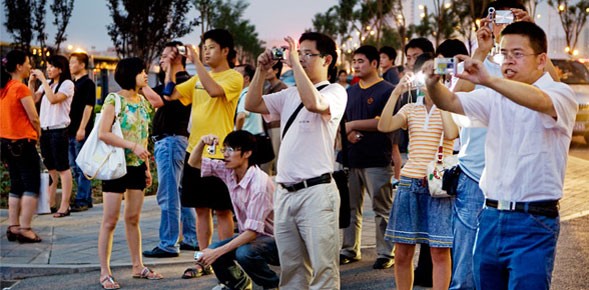Chinese travelers took an estimated 115 million outbound trips in 2014, a more than 18 percent increase over 2013, when around 97 million trips were taken.
by China Luxury Advisors Team
2014 was an eventful one for watchers of the Chinese tourism industry. Despite the damper that the continued crackdown on corruption from the Chinese government placed on government travel and spending, growth in Chinese tourism remained stronger than ever. Chinese travelers took an estimated 115 million outbound trips in 2014, a more than 18 percent increase over 2013, when around 97 million trips were taken.
Last year also marked the much-anticipated Alibaba IPO, making China’s e-commerce powerhouse a household name in the US. The digital juggernaut also rolled out a suite of new products in the US market in 2014, among them the online storefront 11Main, and the cross-border payment and logistics solution Alipay ePass. With these developments, Alibaba has made progress in helping brands sell to Chinese consumers – whether they’re in China or the US – who are seeking authentic American products.
However, arguably the most significant event related to Chinese tourism in 2014 was a surprise announcement by President Obama during his November visit to the APEC Summit in Beijing. The new reciprocal visa agreement reached by the US and China extended business and tourist visas from one to 10 years, and student visas from one to five years. Data from the Chinese online travel site Ctrip.com indicated that applications for US visas shot up 50 percent shortly after the announcement.
The agreement was welcome news for the hospitality and retail industries in the US, both of which expect a continued influx of Chinese guests. According to a statement released this fall by the White House, “as a result of this arrangement, the United States hopes to welcome a growing share of eligible Chinese travelers, inject billions in the US economy and create enough demand to support hundreds of thousands of additional U.S. jobs.”
As 2015 kicks off, China Luxury Advisors predicts the following five Chinese tourism trends to gain pace in the United States:
5) Chinese Tourism to the US Will Outpace Europe and Other Destinations.
Heartened by easier (and longer) visas, more Chinese outbound tourists will opt for trips to the US over popular destinations such as Paris or London. Already seen as an aspirational locale for shopping, education, and real estate, the US will be a major beneficiary as Chinese travelers take more than 200 million outbound voyages by 2020. By 2021, the US expects the number of Chinese tourist arrivals to more than triple to 7 million, contributing more than $85 billion per year to the economy.
4) Chinese Investment in the United States Will Gain Pace.
Expect Chinese companies to buy at least one major Hollywood studio in 2015, and continue to make large-scale investments in other US companies and industries. Some of China’s wealthiest and most powerful businessmen – among them Alibaba’s Jack Ma and Dalian Wanda’s Wang Jianlin – have made clear their intentions to acquire US businesses, particularly in the cinema industry (with Wang of Dalian Wanda purchasing the AMC movie chain in 2012). As Ma put it, “In ten years, I want five of the top ten global movies to be made by Alibaba.”
Look for Chinese companies to also intensify their focus on acquiring high-profile hotels or hotel chains in 2015, coming off of the heels of this fall’s purchase of the iconic Waldorf-Astoria hotel by China’s Angbang Insurance Group for $2 billion.
3) 2015 Will Be the Year of Mobile Innovation for Chinese Tourism.
This year, the number of smartphone users will exceed PC users in China. Younger Chinese consumers in particular have established themselves as highly mobile-savvy, in many cases preferring mobile commerce (m-commerce) to traditional e-commerce, and spending an increasing amount of time using mobile apps such as WeChat to communicate with peers, shop, and interact with brands.
This growing reliance on mobile devices has also extended to the tourism industry. Currently, 40 percent of bookings on the Chinese online tourism-booking site Qunar are made on mobile, and the company’s mobile revenue skyrocketed 400 percent in 2014. This year, look for Chinese travel sites to invest heavily in innovation as a means to remain relevant and compete in a cutthroat market.
2) WeChat Will Extend its Reach Outside of China, in Line With Chinese Tourism Destinations and Trends.
Already the most relevant platform to reach and influence Chinese users, Tencent’s mobile messaging app WeChat is here to stay. Currently with more than 400 million users, WeChat has steadily increased its global footprint, and now boasts some 40 million users outside of China. For many Chinese tourists, WeChat has become an indispensable resource for pre-travel research, and via innovative new features has become a way to interact with travel destinations – and even book trips. For brands, WeChat is arguably the easiest way to interact with Chinese fans worldwide, to provide tools such as global store locators and live-chat customer service to globetrotting shoppers.
This year, look for WeChat to continue its overseas expansion efforts, extending new advanced functions and m-commerce to make it easier than ever for international brands, retailers, hoteliers, and malls to get Chinese travelers in the door and increase conversion rates.
1) 2015 Will Be the Year of the Individual Chinese Tourist.
Building on trends seen over the past several years, 2015 will be the year that the individual Chinese tourist becomes more important to brands and retailers than their group-travel counterpart. The ongoing anti-corruption crackdown has crimped organized group travel among government officials – trips that invariably included high-end shopping excursions. The rise of the independent traveler – typically young, educated, and relatively wealthy by Chinese standards – has been noted by Chinese travel sites such as Ctrip, Caissa, and Qunar, all of which have put more emphasis on tailored experiential travel packages in recent years.
Young tourists have increasingly fueled the emergence of independent Chinese travel. Thirty-eight percent of outbound Chinese travelers are between the ages of 25 and 34, and 67 percent plan to make their own travel arrangements. Additionally, independent travelers have often engaged in group travel in previous years and now opt to go it alone, with greater confidence in their itinerary-building abilities. (A fact that has led to a strong increase in Chinese visits to places off the beaten track.)
Independent travelers are not just important to brands and tourist destinations – they’re increasingly critical, because they influence friends and family, and spend on experiences and accommodations – whereas group travelers typically spend only on shopping trips, skimping on accommodations, food, and experiences.
TravelDailyNews Asia-Pacific editorial team has an experience of over 35 years in B2B travel journalism as well as in tourism & hospitality marketing and communications.




![[PR] PR_Ascott and Vimut Hospital_2024](https://www.traveldailynews.asia/wp-content/uploads/2024/04/PR-PR_Ascott-and-Vimut-Hospital_2024-400x265.jpg)








































































